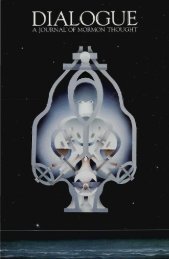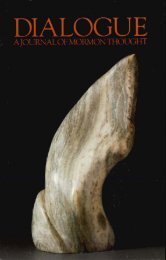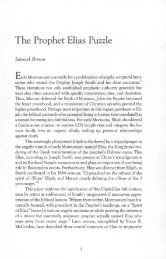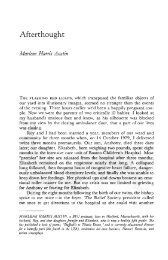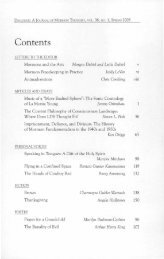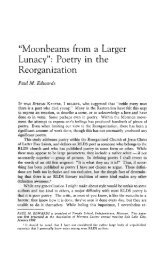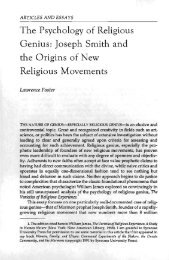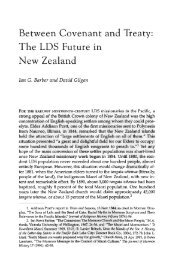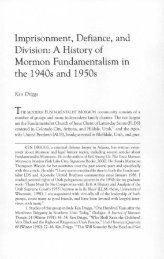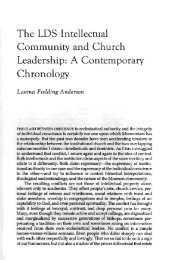Dialogue, Volume 25, Number 2 - Dialogue – A Journal of Mormon ...
Dialogue, Volume 25, Number 2 - Dialogue – A Journal of Mormon ...
Dialogue, Volume 25, Number 2 - Dialogue – A Journal of Mormon ...
Create successful ePaper yourself
Turn your PDF publications into a flip-book with our unique Google optimized e-Paper software.
42 DIALOGUE: A JOURNAL OF MORMON THOUGHT<br />
efforts in Asia and Africa, Latin America, as a whole, comprises the<br />
largest <strong>Mormon</strong> population outside the United States —27 percent <strong>of</strong><br />
total Church membership in 1990. In contrast, the United States had<br />
56 percent {Deseret News Church Almanac 1991). When one considers<br />
these figures in light <strong>of</strong> the ever-increasing Church growth rate, even<br />
in the face <strong>of</strong> terrorist resistance, it becomes evident that Latin American<br />
membership may soon constitute almost half <strong>of</strong> the total Church<br />
population. Thus, it is increasingly important for Latter-day Saints to<br />
understand both the social situation <strong>of</strong> <strong>Mormon</strong>ism and the phenomenon<br />
<strong>of</strong> <strong>Mormon</strong> growth in Latin American society. x<br />
As I write, I live in Argentina, a country whose once-promising<br />
economy has fallen prey to the world-wide financial crisis. The Church<br />
has built a strong base here. Third-generation natives now comprise<br />
a significant portion <strong>of</strong> the vital and visible LDS population. They<br />
have developed a sense <strong>of</strong> religious and historical pride, are involved<br />
in writing the history <strong>of</strong> the Church in Argentina, and engage in oral<br />
history research. To them, Church growth has resulted from a combination<br />
<strong>of</strong> their individual and collective struggles, the work <strong>of</strong> foreign<br />
missionaries, and a substantial outpouring <strong>of</strong> the Spirit.<br />
Other Argentines, however, hold less positive views <strong>of</strong> <strong>Mormon</strong><br />
growth. For example, I recently delivered a series <strong>of</strong> lectures in the<br />
city <strong>of</strong> San Juan. Among other things, I discussed the emergence <strong>of</strong><br />
"new" religions in Bolivia, and the topic <strong>of</strong> <strong>Mormon</strong>s frequently arose.<br />
A number <strong>of</strong> students and faculty explained that the Church had<br />
appeared quite suddenly in their town, beginning with a "massive<br />
invasion" <strong>of</strong> young, blond Americans traveling in pairs. With amazing<br />
rapidity and an apparently tremendous infusion <strong>of</strong> capital, these newcomers<br />
built a "huge," "lavish" chapel. Although these people were<br />
impressed with the Church's missionary, financial, and political<br />
power, as evidenced by this building project, they were also deeply<br />
suspicious, wondering why the <strong>Mormon</strong>s had expended so many<br />
resources just to come to San Juan. Did this expansion fit into some<br />
1<br />
Total<br />
Percentage <strong>of</strong> total<br />
Church membership<br />
LATIN AMERICAN CHURCH MEMBERSHIP<br />
1960 1970 1980<br />
22,503 160,355 519,626<br />
1990<br />
1,949,400<br />
1.3 5.5 11.2 26.7<br />
(Includes Argentina, Bolivia, Brazil, Chile, Colombia, Costa Rica, Ecuador,<br />
El Salvador, Guatemala, Honduras, Mexico, Nicaragua, Panama, Paraguay, Peru,<br />
Uruguay, Venezuela.)<br />
Source: 1990/91 Deseret News Church Almanac.



